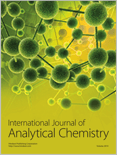
International Journal of Analytical Chemistry
Scope & Guideline
Elevating Knowledge in Analytical Techniques Globally
Introduction
Aims and Scopes
- Method Development and Validation:
The journal publishes research on the development of new analytical methods and their validation, emphasizing the importance of reproducibility and reliability in analytical chemistry. - Environmental and Food Safety Analysis:
Research addressing the detection and quantification of pollutants, pesticides, and heavy metals in environmental samples and food products, highlighting public health implications. - Pharmaceutical Analysis and Pharmacokinetics:
Studies focusing on the analysis of pharmaceutical compounds, their metabolites, and pharmacokinetic properties in biological samples, contributing to drug development and therapeutic monitoring. - Nanomaterials and Green Chemistry:
Exploration of nanomaterials for enhanced analytical applications and the adoption of green chemistry principles to minimize environmental impact. - Biochemical and Clinical Applications:
The journal features studies that apply analytical techniques to biochemical and clinical settings, including diagnostics and monitoring of diseases. - Chemometric Techniques:
Research involving the application of chemometric methods for data analysis, facilitating the interpretation of complex datasets in analytical chemistry.
Trending and Emerging
- Green Analytical Chemistry:
A marked increase in studies promoting environmentally friendly methods and materials in analytical procedures, emphasizing sustainable practices in the field. - Advanced Nanotechnology Applications:
A rising trend towards the use of nanotechnology in analytical methods, including the development of novel nanomaterials for enhanced sensitivity and selectivity in detection. - Multi-Component and Simultaneous Analysis:
Growing interest in methodologies that allow for the simultaneous analysis of multiple components in complex matrices, reflecting real-world applications in food safety and pharmaceuticals. - Integration of AI and Machine Learning:
Emerging research focusing on the application of artificial intelligence and machine learning techniques for data analysis and predictive modeling in analytical chemistry. - Biomarker Discovery and Metabolomics:
Increased emphasis on the identification of biomarkers and the use of metabolomics in clinical and pharmaceutical research, aligning with personalized medicine trends. - Point-of-Care Testing Technologies:
A trend towards developing rapid, portable testing methods for clinical diagnostics, particularly in response to global health challenges such as COVID-19.
Declining or Waning
- Traditional Analytical Techniques:
There has been a noticeable decrease in studies focusing solely on conventional methods such as UV-Vis spectroscopy or basic chromatographic techniques, as researchers increasingly seek novel and more sensitive methods. - Single-Component Analysis:
Research emphasizing the analysis of single compounds without considering multi-component systems has diminished, reflecting a growing interest in complex mixtures and multi-parameter analyses. - Basic Toxicology Studies:
The journal has seen fewer publications centered on basic toxicological assessments without integrating advanced analytical techniques or comprehensive risk assessments. - General Environmental Monitoring:
Research that does not focus on specific contaminants or lacks detailed analytical methodologies has become less frequent, as there is a push towards more targeted and sophisticated environmental assessments. - Low-Impact Studies:
There is a reduction in publications that do not address significant health, environmental, or scientific implications, as the journal seeks to prioritize impactful research.
Similar Journals
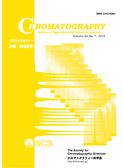
Chromatography
Exploring the frontiers of chromatography and its applications.Chromatography is an esteemed journal published by the SOC CHROMATOGRAPHIC SCIENCES, dedicated to advancing the field of chromatographic techniques and their applications across various disciplines, including analytical chemistry, biochemistry, and environmental science. By facilitating the exchange of high-quality research, Chromatography plays a pivotal role in enhancing methodologies and technologies that drive innovation in sample analysis. While the journal is not currently open access, it maintains a rigorous peer-review process, ensuring the publication of valuable and impactful studies. Researchers, professionals, and students alike can benefit from its comprehensive coverage of chromatography-related advancements, making it a vital resource for anyone engaged in this dynamic area of study.
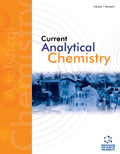
Current Analytical Chemistry
Navigating the landscape of modern analytical chemistry.Current Analytical Chemistry is a pivotal journal in the field of analytical chemistry, published by Bentham Science Publishers Ltd. Established to bridge the gap between fundamental research and practical applications, this journal offers a platform for the dissemination of significant advancements and innovations from the realms of chemical analysis techniques and methodologies. With an impressive scope covering both theoretical and applied analyses, it has successfully secured a Q3 category ranking in the 2023 metrics of Analytical Chemistry, positioned at #75 out of 156 in the Scopus rankings. Researchers, professionals, and students can expect to engage with high-quality content that reflects the latest trends and issues within the discipline. Although it currently does not offer Open Access options, the journal continuously strives to maintain high editorial standards that contribute to its impactful presence in the academic community. The convergence of ideas from 2006 to 2024 promises to uphold its reputation as a reliable source for cutting-edge research in analytical chemistry.
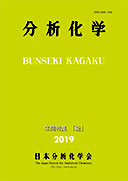
BUNSEKI KAGAKU
Empowering the Next Generation of ChemistsBUNSEKI KAGAKU, published by the Japan Society Analytical Chemistry, is a reputable journal dedicated to the field of analytical chemistry. With an ISSN of 0525-1931, this journal has been a crucial outlet for scholarly communication since its inception in 1952, converging its publication years from 1954 to 1957 and from 1959 to 2024. Although it holds a Q4 category ranking in the most recent 2023 quartiles of analytical chemistry and ranks 153/156 in Scopus, it continues to serve as a platform for quality research, fostering advancements in the field. BUNSEKI KAGAKU is based in Tokyo, Japan, and emphasizes the critical importance of analytical techniques in scientific inquiry. With a commitment to professionalism and rigor, the journal provides a vital resource for researchers, students, and professionals seeking to explore innovative methodologies and contribute to the ongoing dialogue in analytical chemistry.

Glasnik Hemicara i Tehnologa Bosne i Hercegovine
Bridging Gaps Between Science and ApplicationGlasnik Hemicara i Tehnologa Bosne i Hercegovine is a distinguished journal dedicated to advancing the fields of chemistry and technology within Bosnia and Herzegovina and beyond. Published by the University of Sarajevo, Faculty of Science, this academic journal offers a platform for the dissemination of original research, reviews, and case studies that contribute to the rich tapestry of knowledge in chemical sciences and technological applications. With a commitment to promoting open access to vital research, Glasnik Hemicara i Tehnologa cultivates an inclusive environment for researchers, professionals, and students alike, fostering collaboration and innovation. Although specific metrics such as impact factor and H index are yet to be established, the journal's role in bridging academia and industry cannot be overstated, making it an essential resource for those engaged in scientific inquiry in the region.
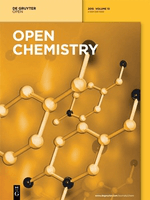
Open Chemistry
Exploring New Horizons in Chemical ResearchOpen Chemistry, published by DE GRUYTER POLAND SP Z O O, is a distinguished peer-reviewed journal that has been serving the global chemistry community since its inception. With an ISSN of 2391-5420 and an E-ISSN also of 2391-5420, this open-access journal has been accessible to researchers and practitioners alike since 2015, ensuring a wide dissemination of high-quality research findings. Located in Germany, specifically at BOGUMILA ZUGA 32A STR, 01-811 WARSAW, MAZOVIA, POLAND, Open Chemistry aims to publish innovative research across various chemical disciplines, with special attention to miscellaneous chemistry and materials chemistry. It is currently ranked in the Q3 category for both fields as of 2023, reflecting its solid standing within the academic community, with specific ranks of 187/408 in General Chemistry and 153/317 in Materials Chemistry, corresponding to respective percentiles of 54 and 51. Open Chemistry not only enhances the accessibility of cutting-edge research but also serves as a vital resource for students, professionals, and scholars seeking to advance their knowledge in the rapidly evolving landscape of chemical sciences.

Jordan Journal of Chemistry
Shaping the Future: Pioneering Chemistry Research and Education.The Jordan Journal of Chemistry is a prominent publication dedicated to advancing the field of chemistry in Jordan and beyond. Published by the Yarmouk University Deanship of Research & Graduate Studies, this journal serves as a platform for researchers, educators, and practitioners to disseminate their findings in a variety of chemistry sub-disciplines. Although currently classified in Q4 of miscellaneous chemistry and ranking within the 9th percentile according to Scopus, the journal plays a crucial role in fostering academic dialogue and collaboration in the region. With its ISSN 1814-9111 and E-ISSN 2079-7249, the Jordan Journal of Chemistry offers open access to researchers from diverse backgrounds, ensuring that critical research is both accessible and impactful. By bridging local studies with global scientific advancements, this journal is poised to contribute significantly to the growth and recognition of chemistry as a key scientific discipline in the region, with convergence efforts set from 2020 to 2024.

Methods and Objects of Chemical Analysis
Bridging Theory and Practice in Analytical ChemistryMethods and Objects of Chemical Analysis is a significant outlet in the field of Analytical Chemistry, published by the prestigious TARAS SHEVCHENKO NATIONAL UNIVERSITY OF KYIV in Ukraine. Since its inception in 2017, this journal has aimed to advance methodological and analytical understanding within the discipline, addressing contemporary issues and innovative techniques. With a Scopus rank of #133 out of 156 and a Q4 Category Quartile for 2023, it offers a platform for researchers and professionals to disseminate crucial findings and methodologies. While currently serving as a traditional journal, it is fostering an academic community focused on impactful research that enhances our understanding of chemical analysis techniques. The journal’s commitment to scholarly rigor and its relevance in a rapidly evolving field make it a valuable resource for students and seasoned researchers alike, seeking to remain at the forefront of analytical advancements.

Brazilian Journal of Analytical Chemistry
Pioneering Analytical Methodologies for a New EraBrazilian Journal of Analytical Chemistry, published by VISAO FOKKA COMMUNICATION AGENCY, serves as a vital platform for those engaged in the field of analytical chemistry, especially within the Latin American context. With an ISSN of 2179-3425 and an E-ISSN of 2179-3433, this journal aims to promote high-quality research and advancements in analytical methodologies, instrumentation, and applications spanning from 2010 to the present. Although it currently holds a Q4 rank in Analytical Chemistry by Scopus and is placed at the 24th percentile, its commitment to open access publishing provides invaluable opportunities for widespread dissemination of knowledge, catering to researchers, professionals, and students alike. The journal's editorial board comprises emerging and established experts aiming to bridge gaps in analytical chemistry research, particularly in a Brazilian and broader South American context. Situated in São Paulo, Brazil, the journal's role in fostering innovation and collaboration in analytical techniques makes it an essential resource for the academic community.
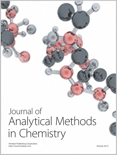
Journal of Analytical Methods in Chemistry
Connecting theory and practice for a brighter scientific future.The Journal of Analytical Methods in Chemistry, published by HINDAWI LTD, stands as a premier platform dedicated to the dissemination of research in the vibrant field of analytical chemistry. With an ISSN of 2090-8865 and an E-ISSN of 2090-8873, this Open Access journal has been committed to providing unrestricted access to quality research since 1978, thereby fostering greater collaboration and innovation among researchers, professionals, and students globally. The journal showcases rigorous research insights spanning diverse categories, earning impressive Scopus rankings including Q2 in Chemical Engineering and Q3 in Analytical Chemistry for 2023, positioning itself effectively among respected peers. Its interdisciplinary approach also covers significant contributions in the realms of instrumentation and computer science applications, thus addressing contemporary challenges and advancements in analytical methodologies. By bridging theoretical underpinnings with practical applications, the Journal of Analytical Methods in Chemistry aims to catalyze knowledge exchange while enhancing the global discourse in analytical science.
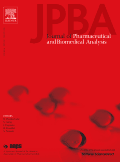
Journal of Pharmaceutical and Biomedical Analysis
Exploring the intersection of analytical chemistry and biomedicine.The Journal of Pharmaceutical and Biomedical Analysis, published by ELSEVIER and available in print and online formats, stands as a pivotal source of knowledge in the realms of Analytical Chemistry, Clinical Biochemistry, Drug Discovery, and Pharmaceutical Science. With an ISSN of 0731-7085 and an e-ISSN of 1873-264X, this journal is dedicated to publishing high-quality research that advances the understanding and development of analytical techniques in pharmaceuticals and biomedicine. The journal has earned a solid reputation, reflected in its Q2 category rankings across five distinct fields for 2023, and boasts impressive Scopus rankings, signaling its robust impact within the academic community. The Journal of Pharmaceutical and Biomedical Analysis serves as an essential resource for researchers, professionals, and students alike, providing actionable insights and fostering innovation that can directly influence future advancements in drug development and biomedical applications.